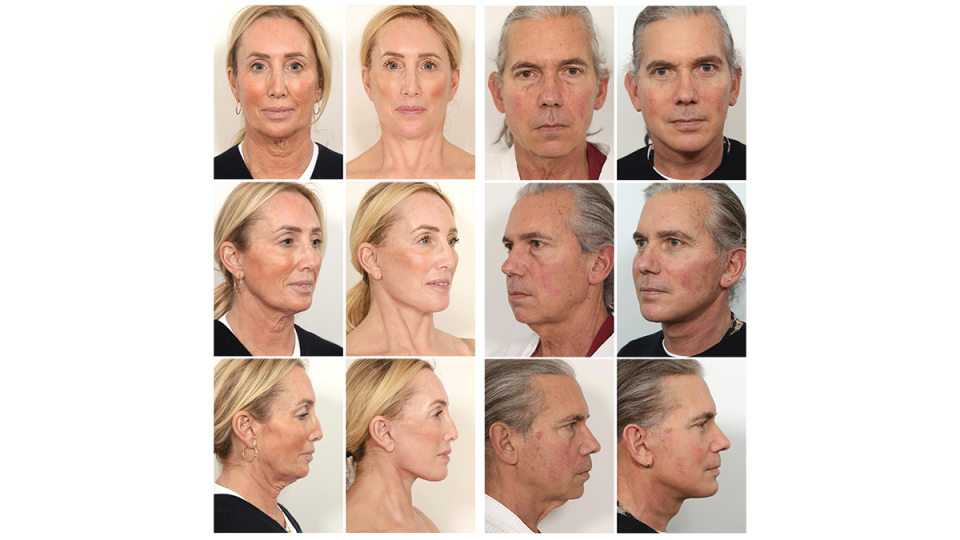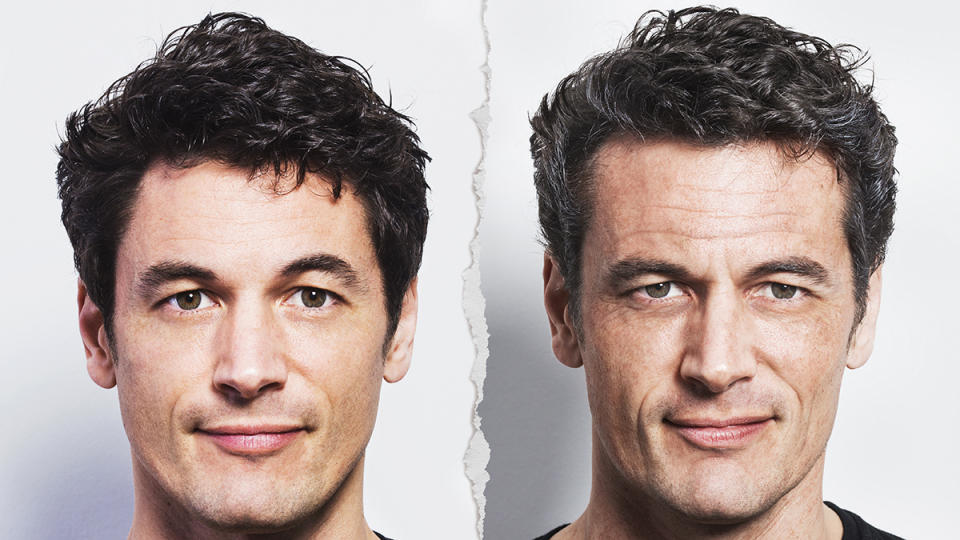How to Get a Facelift and Still Look Like Yourself Afterward

You can lead the healthiest life, follow an optimized skincare regimen, use the top anti-aging devices, and hire the best personal trainer in town, and none of that can prevent the skin from sagging around the neck. Luckily, though, modern-day facelifts are helping people to look as fresh as they feel well into their 60s, 70s, and beyond.
For a long while, the world’s best plastic surgeons were advertising their facelifts as “the tightest in town.” And although any tight facelift will pull jowling skin up and away from the neck, this sole metric does few favors for anyone who wants their results to look natural. Thankfully, modern success metrics veer away from “tight”: Sure, a facelift should firm everything up, but the bigger aim is to reveal a more youthful-looking you.
More from Robb Report
Why Men Are Turning to Cosmetic Procedures for a Competitive Edge in the Boardroom
Forget the Spa. These Non-Invasive 'Tweakments' Use Lasers and Injections to Keep You Looking Young
Wagyu-mart? Inside Walmart's Bold Plan to Lure Luxury Shoppers
Facelifts should help you look “defined” rather than just “tight,” explains N.Y.C.-based facial plastic surgeon Dr. David Rosenberg. He adds that all facelift patients, no matter their age or the degree of adjustments, share the same request: “Everyone says, ‘Make me look like me.’ And that’s a high level of sophistication compared to 15 or 20 years ago. And it requires better surgery.”
Rosenberg is one of the world’s most sought-after experts for the deep-plane facelift, the gold standard of modern plastic surgery that helps lift jowls and sculpt both the neck and cheeks. As the name suggests, a deep-plane facelift goes deeper than other procedures to release specific ligaments along the platysma muscle that extends from the shoulder to the cheeks. The deep-plane facelift also leaves the tissue that connects the face and neck muscles to the skin intact. Most sutures are beneath the surface of the skin, and minor incisions occur behind the ear (and the tragus cartilage in the ear), as well as below the neck. Translation: Less trauma to the skin, no perceptible scarring, longer-lasting results (up to 15 years), and improved definition—that key indicator of success—throughout the jaw, cheeks, chin, and neck.
However, just because you’ve identified the deep-plane facelift as your procedure of choice, doesn’t guarantee it’s going to look as natural as possible. Read on for five points of advice from Dr. Rosenberg and his associate, Dr. Andrew Timberlake, to ensure that your facelift results in “you looking exactly like yourself, only much better”, as Rosenberg puts it.
How to Get the Most Natural-Looking Facelift Results
Frame the Cost as an Investment in Yourself
It’s no secret that cosmetic procedures can be extremely expensive. (Many estimates for deep plane facelifts range between $20,000 to $30,000, but in expensive cities such as New York, the total cost can reach the low six figures.) And unlike many outpatient options like hair transplants—which require a single next-day follow-up exam—a facelift is on the longer side of the recovery spectrum. That’s why it’s important not to look for the cheapest or fastest solution. This procedure is likely because you do not like something about your reflection because of natural and genetic means. So imagine if you cut costs and corners, only to stare back at that regret for the rest of your life. In other words, if you aren’t going to invest in a trained doctor and a reputable clinic, then it may be better not to proceed at all.
There are all kinds of technological innovations in these procedures, notes Timberlake, “But the real innovation is coming from the doctors who have done many thousands of these procedures, and whose hands are trained and steady enough to give you those life-changing results.” Not to mention, the steadiest hands will also limit the amount of tissue damage, so in reality “the fastest recovery” will usually come from the most seasoned doctors.
Adds Rosenberg: “If it costs you tens of thousands of dollars to get a facelift and you end up dissatisfied, then it wasn’t worth a single penny. Those four hours will dictate the next 15 years [or more] of your life.” And if there’s any question about why a clinic is charging a specific amount—beyond the popular demand and reputation of its leads—it might be baked into the after-care protocol, which is well worth the investment, too. (More on that below.)
Dig Deeper Into Before-And-Afters

If you’ve found a potential surgeon for the task, be certain you’ve seen a lot of their before-and-after images from past procedures. I find it most helpful to request images of people who aren’t wearing any makeup in the post-recovery shot (which is common with female patients in particular). Be sure you’re looking at an evenly lit and similarly set-up shot.
“Remember, a doctor will always post their best results online,” says Rosenberg. “So if their best doesn’t look good enough to you, consider elsewhere. Or, if you found them because of their good results, then ask to see more that haven’t been posted.”
(And as a quick aside, Rosenberg says to take note of the clinic facilities and in particular, the operating room; there should be a dedicated operating room, as opposed to a screening room that is transitioned on certain days of the week for operations. These transitional rooms aren’t kept as sterile for the procedures, so it should be a red flag if they don’t have a dedicated operation space.)
With male patients in particular, it might also help to see photos of men with facial hair in both of their before-and-after images. This is because facelift procedures can also pull back the beard hairs towards the incision points. Some doctors may adjust the incision point accordingly, while others will use electrolysis to resculpt the beard lines for a natural result. (The point is, make sure your doctor has a solution in place for you, with Before-and-After results to match the claim.) And on that topic…
Ask About Post-Procedure Care
Up there with seeing a large array of before-and-after images, you should also have a clear understanding of what the recovery timeline and post-procedural care look like at this particular clinic.
The general recovery timeline is uniform: Most deep-plane facelifts require you to wear a compressive strap for a week to restrict swelling and provide neck support. And while you can get up and endure light activity within the first few days, your recovery will ultimately be defined by the care your clinic provides.
As an example, Rosenberg’s team assigns a private-duty nurse to help with dressing the wounds and other supervision for the first two days, then recommends lymphatic drainage around day four or five to reduce swelling and inflammation, as well as a V-beam laser to shorten any bruising time to two to three days (as opposed to three to four weeks without the treatment). For this reason, his clinic requires patients to stay in the NYC metro area for just over a week in order to receive proper post-procedural care. And on top of that, his patients can come in for free checkups as often as they need to—which is especially reassuring if they intend to get future facelifts after the 12 to 15-year lifespan of the first one.
So, if your potential clinic isn’t promising the kind of post-procedural care that keeps you assured, it may be worth shopping around for new options. (And while a dedicated private nurse may not be necessary, there needs to at least be protocol in place for emergency needs. Someone on call, someone nearby, some solution like that, bottom line.)
Chill Out for a While
Beyond the first two weeks of visible healing, you still need to keep a low profile for a while. You might return to work, but should refrain from intense physical exercise for the first four to six weeks, including sex. The key aim here is to let everything heal without any compromise—especially since the goal is to skirt by without many people noticing you got the facelift. By all means, resist the urge to do pushups in your first-week boredom, says Rosenberg. “You can pop a blood vessel and that’s going to bring you back to the operating room.”
However, if you’ve been considering multiple procedures at once—say a rhinoplasty, brow lift, and beyond—then it could be worth combining these efforts and recovering over the same period. The feasibility will depend on the severity of the treatments, so talk to your surgeon(s) about this approach.
Don’t Jump at the First Sign of Sagging

When is the best time to get a facelift? The answer is both direct and vague.
“Whenever you wake up over and over and see something that bothers you when you look in the mirror,” says Timberlake. “The same as you would with other cosmetic procedures like a rhinoplasty or blepharoplasty.” But he adds that it’s not quite as simple as that: While this sagging of the platysma neck muscle tends to express itself most from the mid-40s onward, the timeline varies for everyone.
And even if you notice it at, say, 45, you may want to put it off a few years—only because current technology allows us to have roughly three facelifts over the course of one’s life before the results steer away from looking natural. By that math, you could endure until 90 if you start at 45, yes. But starting in your mid-50s (the more common starting point, per Rosenberg’s and Timberlake’s intake), you could still get close to 65 or 70 after just one facelift runs its course.
Of course, you never know what curveballs life will throw, from your own expiration date to the advancement in new technologies, which is why both doctors say to inquire about a facelift if it’s absolutely something you want to do. And while they generally won’t perform the deep-plane procedure on anyone below this mid-40s threshold, there are plenty of other procedures (including non-surgical) to keep you looking fresher and as youthful as possible along the way.
“You have options,” says Rosenberg. “Vibrancy is extending. Being 55 used to mean you were over the hill, but now people are well into their 70s and still on the A-game. That’s enthralling, and we all share that aspiration. We can all relate to the desire to look as good and as young as we feel.”
Best of Robb Report
Sign up for Robb Report's Newsletter. For the latest news, follow us on Facebook, Twitter, and Instagram.

 Yahoo Lifestyle
Yahoo Lifestyle 
